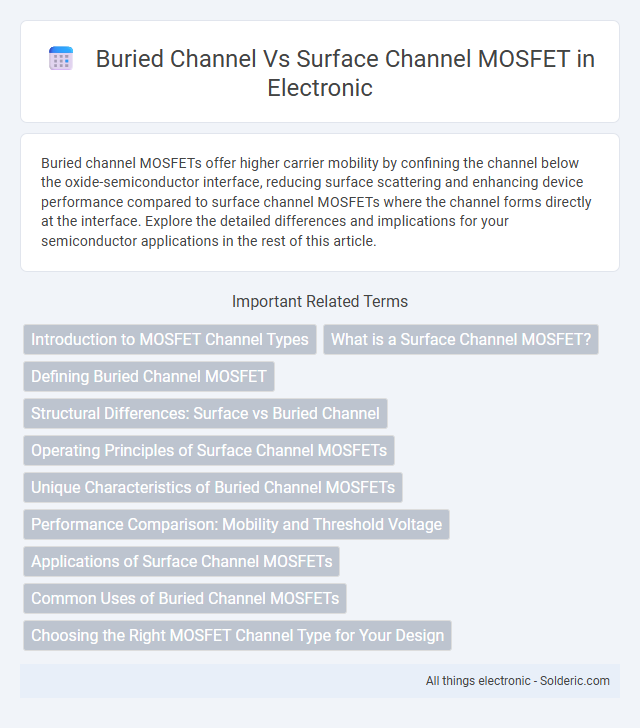Buried channel MOSFETs offer higher carrier mobility by confining the channel below the oxide-semiconductor interface, reducing surface scattering and enhancing device performance compared to surface channel MOSFETs where the channel forms directly at the interface. Explore the detailed differences and implications for your semiconductor applications in the rest of this article.
Comparison Table
| Feature | Buried Channel MOSFET | Surface Channel MOSFET |
|---|---|---|
| Channel Location | Below the silicon surface | At the silicon surface |
| Carrier Mobility | Higher mobility | Lower mobility due to surface scattering |
| Threshold Voltage | Lower threshold voltage | Higher threshold voltage |
| Subthreshold Slope | Better (steeper) subthreshold slope | Worse subthreshold slope |
| Fabrication Complexity | More complex process | Simpler to fabricate |
| Short Channel Effects | Better resistance to short channel effects | More susceptible to short channel effects |
| Applications | High-speed and low-noise circuits | General-purpose digital circuits |
Introduction to MOSFET Channel Types
MOSFET channel types include buried channel and surface channel configurations, each impacting device performance and electrical characteristics. Buried channel MOSFETs have their conductive channel formed below the semiconductor surface, reducing surface scattering and improving carrier mobility. Surface channel MOSFETs, by contrast, establish the conductive path directly at the semiconductor-oxide interface, facilitating simpler fabrication but often experiencing higher surface trap densities affecting threshold voltage stability.
What is a Surface Channel MOSFET?
A Surface Channel MOSFET is a type of metal-oxide-semiconductor field-effect transistor where the conduction channel forms directly at the semiconductor-oxide interface on the surface of the substrate. This device operates by creating an inversion layer beneath the gate oxide, allowing current to flow easily between the source and drain terminals. Surface Channel MOSFETs typically exhibit high electron mobility and are widely used in digital circuits due to their fast switching characteristics.
Defining Buried Channel MOSFET
A Buried Channel MOSFET features a conduction channel formed deeper within the semiconductor substrate, beneath the surface oxide layer, in contrast to the Surface Channel MOSFET whose channel lies at the semiconductor-oxide interface. This buried channel reduces surface scattering and traps, enhancing carrier mobility and resulting in higher drive currents and improved device performance. Buried Channel MOSFETs are particularly advantageous in high-speed and analog applications due to their lower noise and better transconductance characteristics.
Structural Differences: Surface vs Buried Channel
Surface channel MOSFETs feature the conduction channel formed directly at the semiconductor-oxide interface, whereas buried channel MOSFETs have the channel located deeper within the substrate, beneath the surface layer. This structural difference impacts electron mobility; buried channels often exhibit higher mobility due to reduced scattering at the interface. Understanding these distinctions helps optimize device performance for your specific applications in analog and digital circuits.
Operating Principles of Surface Channel MOSFETs
Surface channel MOSFETs operate by forming a conductive channel at the semiconductor-oxide interface when a voltage is applied to the gate electrode, creating an inversion layer that allows current to flow between the source and drain terminals. The channel is composed of majority carriers attracted to the surface, enhancing carrier mobility and enabling faster switching speeds compared to buried channel devices. This direct control over the surface charge distribution results in better device performance in low-voltage applications and improved linearity for analog circuits.
Unique Characteristics of Buried Channel MOSFETs
Buried channel MOSFETs feature a conduction channel formed beneath the gate oxide, minimizing surface scattering and enhancing carrier mobility compared to surface channel devices. This unique structure leads to lower threshold voltages and reduced hot electron effects, improving device reliability and performance in high-speed applications. The buried channel also enables enhanced drive current and lower on-resistance, making these MOSFETs ideal for analog and RF circuits requiring high transconductance.
Performance Comparison: Mobility and Threshold Voltage
Buried channel MOSFETs exhibit higher carrier mobility due to reduced surface scattering, enhancing drive current and switching speed compared to surface channel MOSFETs. Threshold voltage in buried channel devices tends to be lower and more stable, resulting in better control over the device turn-on characteristics. Surface channel MOSFETs often have higher threshold voltages and experience mobility degradation due to interface trap densities at the oxide-semiconductor boundary.
Applications of Surface Channel MOSFETs
Surface channel MOSFETs are widely used in digital integrated circuits, such as microprocessors and memory devices, due to their high electron mobility and fast switching speed. These transistors are essential in complementary metal-oxide-semiconductor (CMOS) technology, enabling low power consumption and high integration density. Their compatibility with standard silicon processing makes them ideal for scalable semiconductor manufacturing in consumer electronics.
Common Uses of Buried Channel MOSFETs
Buried channel MOSFETs are predominantly used in high-performance analog circuits and memory devices due to their lower noise and higher transconductance compared to surface channel MOSFETs. They excel in applications requiring stable threshold voltage and enhanced carrier mobility, such as MOS dynamic RAM (DRAM) cells and precision analog amplifiers. Their buried channel structure reduces surface scattering, making them ideal for sensitive signal processing tasks.
Choosing the Right MOSFET Channel Type for Your Design
Choosing the right MOSFET channel type for your design depends on the application's performance requirements and fabrication constraints. Buried channel MOSFETs offer higher electron mobility and faster switching speeds due to reduced surface scattering, making them ideal for high-frequency circuits. Surface channel MOSFETs provide better threshold voltage control and robustness against interface defects, suited for low-power and general-purpose analog applications.
Buried Channel vs Surface Channel MOSFET Infographic

 solderic.com
solderic.com